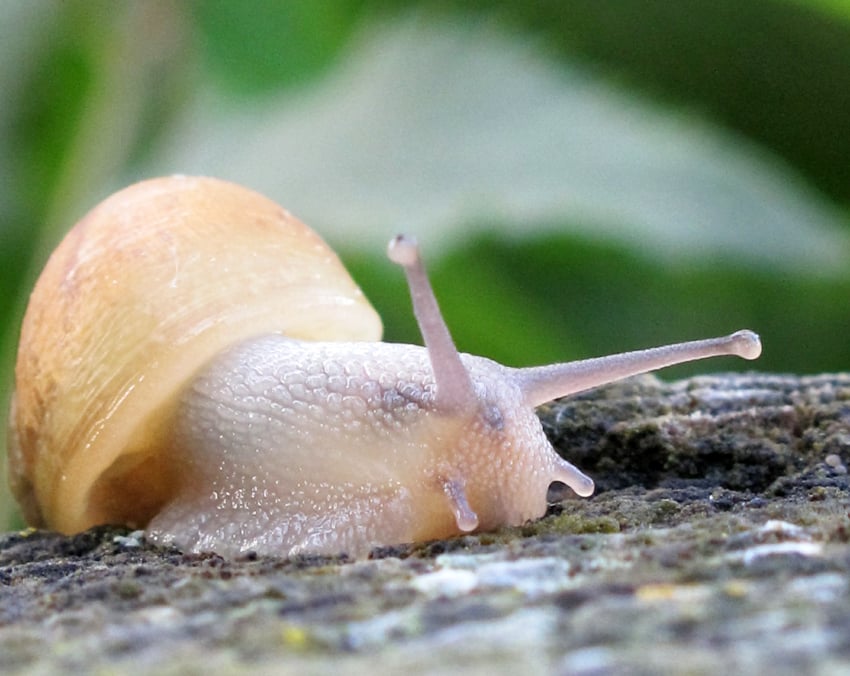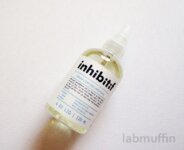Snail slime is the current It Girl in skincare. It’s been used since ancient times, and was revived in South American about 20 years ago as creme or gel de caracol, with brands such as Elicina. It really took off a few years when East Asian beauty companies caught wind of it and started jamming it into everything, from eye cream to BB cream. Today I’m going to go through some of the science behind snail slime.
What is snail slime?
The snail slime used in beauty products comes from the species Cryptomphalus aspersa (which used to be known as Helix aspersa Müller), which is the humble garden snail. The slime is usually listed in ingredients lists as snail secretion filtrate.
Snails actually release several types of slime, and it’s actually the slime that’s produced when the snail is stressed that’s in the products, not the stuff that they use to lube up the ground. The slime is commercially harvested by stressing cultivated snails, such as by poking them with a stick, or by feeding them salty water. The slime is purified by filtration (hence “secretion filtrate”). The snails aren’t killed in the process since they release unwanted chemicals when they die, but it doesn’t sound particularly pleasant either!
What’s in snail slime?
Snail slime contains a complex mixture of chemicals which normally help regenerate snail cells after they’ve been injured.
The mix includes:
- Glycosaminoglycans and proteoglycans – sugar-based molecules which can act as humectant moisturisers
- Allatoin – a soothing moisturiser
- Collagen and elastin – proteins which are too big to actually get through the skin, but might have a humectant effect
- Glycolic acid – chemical exfoliant and humectant
- Hyaluronic acid – humectant moisturiser
- Antimicrobial peptides – kill microbes
- Glycoprotein enzymes, copper peptides, zinc, iron, copper and manganese – not sure if these will do much. Some copper peptides (like GHK-Cu) can do some cool things, but “copper peptides” is a super broad description.
What does it do?
From the components in snail slime, it’s pretty clear that it’s going to be a pretty hardcore humectant moisturiser. But it could potentially do more!
A few in vitro studies have found some ways that snail slime might work on skin. Firstly, it can act as an antioxidant by scavenging free radicals and increasing the activity of superoxide dismutase (SOD), an enzyme which disables some free radicals. It also improves the structural support holding the skin up, by increasing the production and resilience of fibroblasts, and promotes assembly of the extracellular matrix. It also reduces the amount of matrix metalloproteinase, which normally breaks down collagen.
This sounds exciting, but does it translate when we use it on actual skin?
There have been a few clinical trials on snail slime, which doesn’t sound like much, but in the world of cosmetics ingredients this is pretty impressive! However, they use small sample sizes and only one is double-blind, controlled and randomised, which means their results should be taken with a grain of salt.
The most exciting results are from conditions that you wouldn’t normally treat with over-the-counter beauty creams – radiation burns and regular burns. Snail slime made the wounds heal faster. However, a Korean study on atopic dermatitis (eczema) didn’t find that snail slime did anything spectacular.
Then we get to normal skin (albeit slightly damaged from the sun) – it improved hydration and smoothness and reduced wrinkle depth, and while it’s tempting to say that it’s improving the structure of the skin, it’s more likely that it’s mostly the added hydration.
Overall
The scientific evidence that snail slime can actually help regenerate skin, particularly with unbroken skin, is pretty scarce. But it’s likely to be an absolutely fantastic moisturiser!
References
In vitro cell and molecular study on snail secretion mechanism: A. Brieva, N. Philips, R. Tejedor, A. Guerrero, J.P. Pivel, J.L. Alonso-Lebrero and S. Gonzalez. Molecular Basis for the Regenerative Properties of a Secretion of the Mollusk Cryptomphalus aspersa. Skin Pharmacology and Physiology 2008, 21, 15–22. doi: 10.1159/000109084
Clinical trial on 27 adults with deep partial thickness facial burns: D. Tsoutsos, D. Kakagia and K. Tamparopoulos. The efficacy of Helix aspersa Müller extract in the healing of partial thickness burns: A novel treatment for open burn management protocols. Journal of Dermatological Treatment 2009, 20, 219-222. doi: 10.1080/09546630802582037
Randomised controlled trial using 8% and 40% serum daily on 25 subjects with moderate to severely photodamaged facial skin: S.G. Fabi, J. L. Cohen, J.D. Peterson, M.G. Kiripolsky and M.P. Goldman. The effects of filtrate of the secretion of the Cryptomphalus aspersa on photoaged skin. Journal of Drugs in Dermatology 2013, 12, 453-457. (link)
Trial on 15 subjects with photoaging (no placebo not blinded): M J Tribó-Boixareu, C Parrado-Romero, B Rais, E Reyes, M A Vitale-Villarejo and S González. Clinical and histological efficacy of a secretion of the mollusk Cryptomphalus aspersa in the treatment of cutaneous photoaging. Cosmetic Dermatology 2009, 22, 247-252. (link)
Double-blind randomized controlled study on 20 subjects with atopic dermatitis: M-J Oh, S-M Park and H-T Kim. The Effects of Snail Secretion Filtrate on the damaged skin barrier’s recovery of the Atopic dermatitis. The Journal of Korean Oriental Medical Ophthalmology and Otolaryngology and Dermatology 2010, 23, 138-153. (link)
In vitro skin cell migration assay: M. C. Iglesias-de la Cruz, F. Sanz-Rodríguez, A. Zamarrón, E. Reyes, E. Carrasco, S. González and A. Juarranz. A secretion of the mollusc Cryptomphalus aspersa promotes proliferation, migration and survival of keratinocytes and dermal fibroblasts in vitro. International Journal of Cosmetic Science 2012, 34, 183–189. doi: 10.1111/j.1468-2494.2011.00699.x (full text)
In vitro study of the regenerative abilities of snail egg extract: J. Espada, M. Matabuena, N. Salazar, S. Lucena, O. Kourani, E. Carrasco, M. Calvo, C. Rodríguez, E. Reyes, S. González and A. Juarranz. Cryptomphalus aspersa mollusc eggs extract promotes migration and prevents cutaneous ageing in keratinocytes and dermal fibroblasts in vitro. International Journal of Cosmetic Science 2015, 37, 41–55. doi: 10.1111/ics.12167







I looooove snail slime. I’m using the CosRx Advanced Snail 96 Mucin Power Essence. I didn’t realize how much they were irritated though to harvest the slime 🙁
I’m not sure exactly how much, and I don’t think they’ve quantified it – it could be equivalent to a gentle tickle, it could be like a million papercuts… but I’m guessing since it’s a stress product, it’s not that pleasant for them!
This just sounds cruel and gross 🙁
I’m with you on the unpleasant, but I’m OK with the gross! I’ve tried way more gross things 😛
Aw, it doesn’t sound like a nice way to get the ingredient; however, I’ve tried a sheet mask with snail and boy, it works incredibly well. My skin was plump and hydrated ~ amazing.
Monica.
I’ve heard such good things about its moisturising power!
Is this considered vegan? Seems like it would be right there with things like beeswax or oyster sauce.
Definitely not! I think vegan products exclude everything that’s animal-derived, regardless of whether the animal directly suffers or not.
This sounds so gross! There are so many effective moisturizers available, why use snail slime?
That’s how I feel about it too! I’m willing to accept evidence that it’s not that bad for the snails, but I haven’t found any yet.
i am really, really terrified of snails. I used to completely freeze up when I saw them on the ground, particularly if they’re big. This trend has been extremely disturbing for me especially having to see the pictures of snails everywhere (I very hurriedly scrolled past your pic, lol.)
I would never ever ever ever ever put this on my face EVER. Even if I had a radiation burn I would have to reconsider.
Hahaha! My sister is the ABSOLUTE OPPOSITE. She LOVES snails. She used to go around as a kid collecting snails and playing with them (probably more like torture for them…). I think the last time she did it was when she was around 20. She’s such a freak!
Same for my best friend . She goes around school collecting them and she has a tank of them at home.She feeds them lettuce and when she saw a girl in our class using snail slime lip balm they’ve become worst enemies ever since
Think I’ll stick with the fabulous petrolatum as a moisturizer :p
Thanks for summarizing the science on snail slime ) it’s true there isn’t enough scientific evidence, but it’s the problem we have with almost all skin care ingredients, there is just not enough money for to study everything. Theoretically, snail filtrate is very promising.
At least we know for sure that its a good moisturizer
Although it’s kind of gross at first, I like snail products 🙂 lol
Beautish.byMaya
Merely wanna say that this is very helpful, Thanks for taking your time to write this.
I love so much your blog and your evidence-based approach!
Thank you so much! 😀
I think you mean ‘allaNtoin’!
I had assumed that snail slime was just the new pearl powder, so these studies are very interesting. It’s terribly sad that snails are slowly tortured, however. Who knew snail slime had such a science fictional edge.
Did any of the studies touch on keloid scarring? I have an itchy, raised keloid scar from a C-section, which is in a spot that is truly not acceptable to scratch in polite company, and although I try to be kind to animals I confess that I would _personally_ torture a small herd of snails to reduce the scarring when I (probably) get another C-section for B2.
I use it daily on my face, under my moisturizer, and on the back of my hands to diminish age spots (yup, works on those too). After reading some reviews, I have tried it on small oven burns and it has not only healed them quicker, but also took away the pain within 15 minutes. I haven’t (wouldn’t) try it on an open wound. I have also tried it on bruises, and they seem to break up and disappear much quicker than normal.